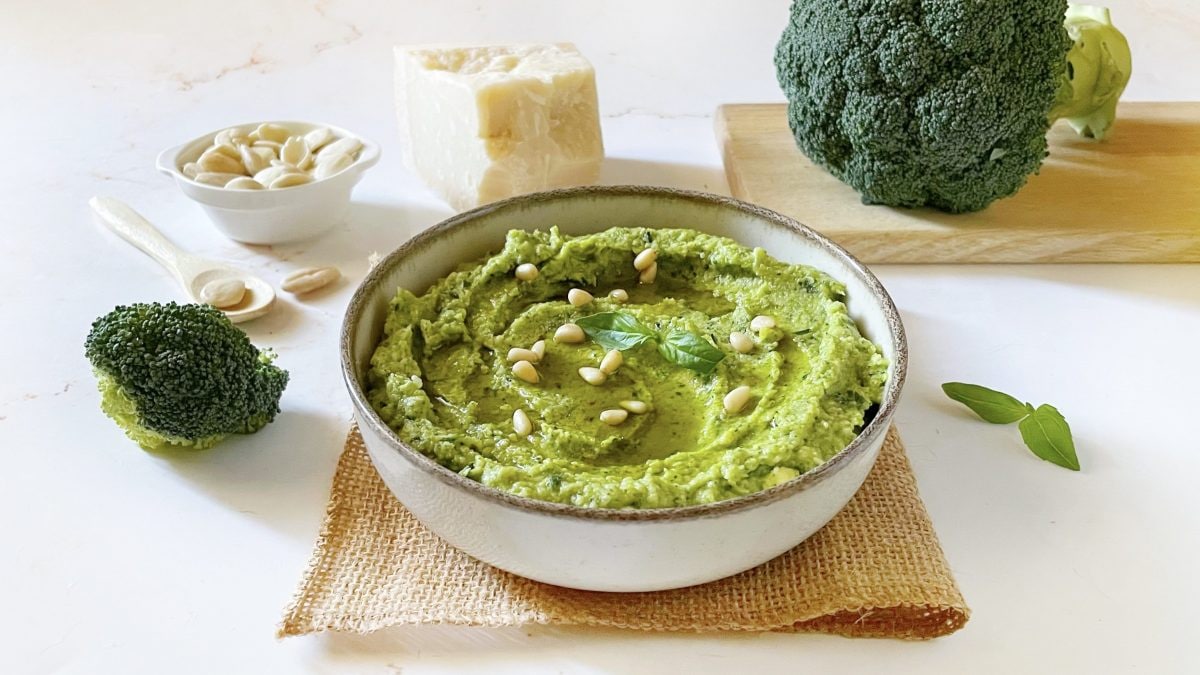
Broccoli Pesto is a tasty and fragrant condiment that can remind you at first glance, for its color and consistency, of the classic pesto alla genovese. In our recipe, the broccoli florets, lightly blanched and then passed in water and ice, are carefully drained and then blended in the jug of a mixer with extra virgin olive oil, grated parmesan, pine nuts, almonds, garlic and fresh basil: for a fragrant and enveloping cream, perfect to bring to the table in winter, when these versatile vegetables are in season.
What is Broccoli Pesto?
Broccoli pesto represents a modern evolution of the classic Ligurian pesto—from traditional basil-based sauces to inventive, vegetable-forward variants. The concept of non-basil “pestos” actually dates back to Ancient Rome, where people prepared herb-and-cheese pastes with local greens and nuts rather than basil. As pesto gained international popularity in the 20th century, creative cooks began using broccoli—often blending its florets with garlic, cheese, nuts, and olive oil—to make a vibrant green sauce that nods to Italian tradition while introducing a fresh twist.
In Italy, this broccoli-forward variation is loved especially by home cooks seeking healthy, versatile spreads for pasta, vegetables, or bruschetta. Meanwhile in the U.S., broccoli pesto benefited from two culinary currents: the 1980s–90s fascination with Italian food and growing interest in health-conscious dishes. Inspired by pioneering American food writers like Angelo Pellegrini, who published pesto recipes in the mid-20th century, and boosted by the rise of alternative pesto recipes (including broccoli versions) in popular cooking media, Americans embraced broccoli pesto as an easy way to sneak extra vegetables into meals. California’s farm-to-table movement and national supermarket availability of pesto helped solidify broccoli pesto’s place on U.S. tables.
Pro Tips for The Best Broccoli Pesto
- Adjust the garlic and cheese quantities to your taste. Too much garlic can overpower the delicate sweetness of the broccoli, while the right amount of cheese adds depth and umami.
- For a rustic texture, pulse the ingredients instead of pureeing them completely. This creates a more interesting mouthfeel and preserves some of the broccoli’s integrity.
- A touch of lemon juice or zest added at the end can brighten the overall flavor and cut through the richness of the cheese and nuts.
Should I Boil Broccoli Before Blending Them for Pesto?
Yes, you should briefly boil (blanch) the broccoli before blending it for pesto. This step softens the florets, making them easier to blend into a smooth sauce while preserving their bright green color and mild flavor.
Boiling also reduces bitterness and enhances digestibility. For best results, boil for 3–4 minutes, then immediately transfer the broccoli to ice water to stop the cooking process before blending with the other ingredients.
Can I Use Frozen Broccoli For This Recipe?
Yes, you can use frozen broccoli for this recipe. Just make sure to thaw it completely and drain any excess water to avoid a watery pesto. Briefly reheating or blanching the thawed broccoli can help revive its color and texture. While fresh broccoli offers a slightly better flavor and firmness, frozen broccoli is a convenient and perfectly acceptable alternative.
Can I Add Any Other Flavorings to This Pesto?
Absolutely! Add a squeeze of lemon juice or zest for brightness, a pinch of red pepper flakes for heat, or fresh herbs like parsley, or mint for added freshness. Sun-dried tomatoes or anchovies can bring umami depth, while a touch of ricotta or cream cheese adds richness.
Can I Use Different Nuts?
Walnuts, cashews, pistachios, or even sunflower seeds make great alternatives to almonds and pine nuts. Each brings its own unique flavor and texture—walnuts offer earthiness, cashews give creaminess, and pistachios add a sweet, nutty note. Just be sure to toast them lightly first to enhance their taste and blend them smoothly into the sauce.
What Can I Use It For?
Once ready, you can use the pesto to season a main dish, such as spaghetti, basmati rice or couscous, to accompany a grilled fish fillet or to flavor boiled potatoes. If you like, you can also transfer it to a piping bag and use it to fill vol-au-vents and tartlets at brunch time, or you can spread it on crunchy bruschetta at the start of the meal.
How Long Will It Last?
Broccoli pesto will last up to 5–7 days in the refrigerator when stored in an airtight container. To help preserve its color and freshness, pour a thin layer of olive oil over the surface before sealing.
Can I Make It Ahead of Time?
Yes! Preparing it in advance allows the flavors to meld beautifully. Store it in an airtight container in the fridge with a thin layer of olive oil on top to prevent oxidation. It will stay fresh for up to a week.
Does It Freeze Well?
Yes, broccoli pesto freezes very well. To preserve its flavor and texture, portion it into small containers or ice cube trays, then transfer the frozen cubes to a sealed bag or container. This way, you can thaw only what you need. It maintains good quality for up to 3 months in the freezer. Just let it thaw in the fridge or at room temperature before using.
How to Store Any Leftovers
To store leftover broccoli pesto, transfer it to an airtight container and smooth the surface with a spoon. Drizzle a thin layer of olive oil on top to help prevent air exposure and discoloration. Keep it refrigerated and use within 5–7 days.
Ingredients
How to Make Creamy Broccoli Pesto

Clean the broccoli and divide them into florets.
Clean the broccoli and divide them into florets.

Blanch the vegetables for 5 minutes in lightly salted boiling water. Once the time has passed, immediately transfer them to a bowl with water and ice, so as to keep their bright green color alive, then drain them and pat them dry with a sheet of kitchen paper.
Blanch the vegetables for 5 minutes in lightly salted boiling water. Once the time has passed, immediately transfer them to a bowl with water and ice, so as to keep their bright green color alive, then drain them and pat them dry with a sheet of kitchen paper.

Blend the broccoli in a blender jug with a clove of garlic.
Blend the broccoli in a blender jug with a clove of garlic.

Add the dried fruit, the chopped basil leaves, the grated parmesan and a pinch of salt, then pour in the extra virgin olive oil.
Add the dried fruit, the chopped basil leaves, the grated parmesan and a pinch of salt, then pour in the extra virgin olive oil.

Work everything well until you obtain a smooth and homogeneous cream.
Work everything well until you obtain a smooth and homogeneous cream.

Then transfer the broccoli pesto into a small bowl, sprinkle with a few pine nuts if desired and garnish with fresh basil leaves. Enjoy!
Then transfer the broccoli pesto into a small bowl, sprinkle with a few pine nuts if desired and garnish with fresh basil leaves. Enjoy!
;Resize,width=767;)
